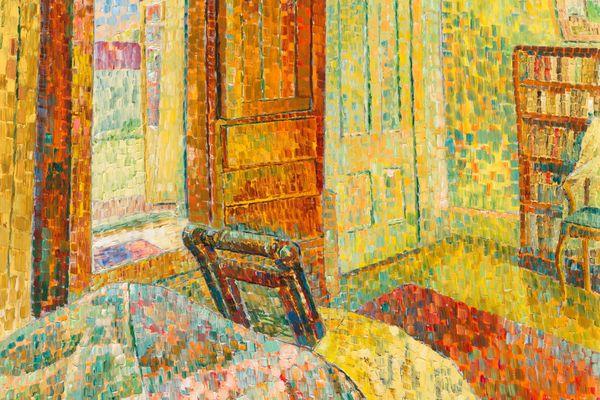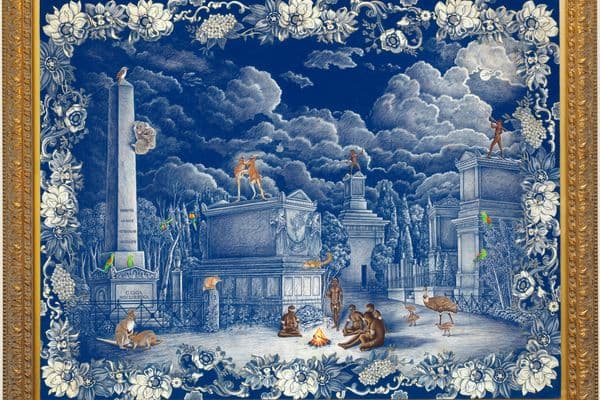Edward Ruscha

Portrait of Edward Ruscha
Gift of Kenneth Tyler 2002
Photographer: Ken Fabrick
Edward Ruscha was born in Omaha, Nebraska, and raised in Oklahoma City. In 1956 he moved with his good friend, the musician Mason Williams, to Los Angeles where he has lived ever since. Once in Los Angeles, Ruscha regularly travelled between California and Oklahoma and his experiences of the road and of the city of Los Angeles have always provided rich material for his art, which features images of roads and roadside culture, the western horizon, Angeleno architecture and, especially, words: the Hollywood sign, title pages of comic books and his own artist’s books, vernacular expressions and clichés.
Soon after first arriving in Los Angeles, Ruscha enrolled at the Chouinard Art Institute, where he studied until 1960. Chouinard (now the Californian Institute of the Arts or “Cal Arts”) has become one of the most highly regarded of the many art schools in Los Angeles. However, in 1956 it was known primarily as a training ground for illustrators and animators. Sponsored by Walt Disney, the school attracted a number of young students interested in careers in commercial art, including Larry Bell, Joe Goode and Llyn Foulkes. Many of these students would go on to become significant members of the vibrant west coast art scene that centred around galleries such as Ferus Gallery and Huysman Gallery, both on La Cienega Boulevard, Los Angeles.
Ruscha’s career as a commercial artist would, however, be short–lived and spasmodic. During the year following art school he worked as both a graphic designer and a printer’s devil, and between 1965 and 1967 he designed the pages of the then Los Angeles-based art journal Artforum, for which he produced some of his finest commercial work.
Ruscha ‘decided’ to become an artist in 1957, when he saw a reproduction of Jasper Johns’s Target with four faces 19551 in an article in the design journal Print. Johns’s painting radically challenged the ideas about art that were being taught at Chouinard. As Ruscha has commented:
Target with four faces was hot. It was a very threatening, challenging work. The teachers at Chouinard didn’t like this unconventional kind of art. They took it as an offense. It went against everything they taught us. They taught us asymmetrical art, and that thing was symmetrical. I was overwhelmed by this contrary work of art. I was so disarmed and puzzled by it that it gave me strength. And I loved it for that. [2]
His interest in art was consolidated during a 1961 visit to Europe, where he acquainted himself with 20th-century and contemporary European practice. On return to the United States, he was included in Walter Hopps’s important 1962 exhibition The new painting of common objects at the Pasadena Art Museum (now the Norton Simon Museum of Art), a show that also included the work of Roy Lichtenstein and Andy Warhol. Ruscha’s first solo exhibition took place the following year at Ferus Gallery. He would soon feature in many of the world’s leading surveys of contemporary art—the Paris Biennale of 1967, the Venice Biennale of 1970, the Corcoran Biennale of the following year, Documentas 5 of 1972, 7 of 1982 and 9 of 1992, the Whitney Biennales of 1987 and 1989 — as well as many group exhibitions that sought to document the specific nature of American and West Coast art, contemporary printmaking and artist’s books.
Ruscha’s prints and books
Ruscha is often regarded as primarily a “graphic artist”3 largely on account of the critical and historical prominence of his 17 photographic books and his many lithographs, screenprints and etchings. He has worked with North America’s and Europe’s finest print workshops, including the Los Angeles-based Tamarind, Cirrus Editions and Gemini GEL (where he worked with Ken Tyler), the Bay Area’s Crown Point Press and Editions Alecto in London.
There have been periods in Ruscha’s career wholly devoted to the production of works on paper. Between 12 December 1969 and 29 February 1972 he stopped painting altogether to focus on graphic work and drawing.4 Ruscha has been very clear about his relationship to the print, which turns around the fact that it can be sold to a potentially vast audience:
Printmaking is glorified as a great art at the expense of people knowing it’s a fantastic marketable item. [5]
Like his paintings, Ruscha’s prints often depict words—words found on architecture, floating in ambiguous spaces and made with ribbons of white paper. Words are used by Ruscha as malleable materials or objects, and he often creates games with the meaning, sound and image of particular words. His use of alliteration (News, mews, pews, brews, stews & dues 1970) attends to words as sounds, while his calligrams (Lisp 1970 and Drops 1971) reproduce words as visual matter, where form directly transcribes meaning. Words as objects found in urban environments—especially in and around Los Angeles—are also depicted (Standard station 1966, Fruit Metrecal, Hollywood 1971). In these cases, architectural words operate as calligrams (the Standard signs are all the same) and, in the case of the Hollywood sign, as markers of place and myth. The mechanical process of printmaking and the artist’s continual duplication of the same word across many works replicates the experience of encountering words in urban spaces.
Ruscha’s interest in the painted, drawn and printed word is also tied to the fact that they have no relationship to the material world. For Ruscha, the word has no resemblance to the real world:
“Words exist in a world of no-size. Take a word like ‘smash’—we don’t know it by size. We see it on billboards, in four-point type and all stages in between … [words exist] in this anonymous world of no-size.” [6]
Text by Shaune Lakin, Senior Curator, Photography
Works in the Kenneth E. Tyler Collection
Browse all works by Edward RuschaFurther Reading
EXHIBITIONS
- California Cool: Art in Los Angeles, 1960s-70s, 2018–19
- Word as Image, 10 March – 4 June 1989
NATIONAL GALLERY PUBLICATIONS
- California Cool, exhibition catalogue, 2018
- Workshop: The Kenneth Tyler Collection, Jane Kinsman (ed.), 2015
RELATED LINKS




///national-gallery-of-australia/media/dd/images/20241204_Rebecca_Edwards-1.jpg)






